|
 Dwight Peck's personal website Dwight Peck's personal website
Winter 2022-2023
A photographic record of whatever leapt out at us
You may not find this terribly rewarding unless you're included here, so this is a good time for casual and random browsers to turn back before they get too caught up in the sweep and majesty of the proceedings and can't let go.
The National Gallery of Art, Washington, D.C. {2}
Wonderful odds and ends through the Renaissance and Medieval rooms
(mostly personal favorites, but few of which we've seen in person)

We resume from the first webpage with this parade of Virgin-and-Child renderings; not too much variety, but fun comparisons. This is by Benvenuto di Giovanni of Siena, dated 1480/85, and it features Saints Jerome and Bernardino of Siena. Curly-headed Christ Child is make a first shot at getting the blessing gesture down, so important later on; the pomegranate is symbolic of both the Church and Christ's blood at the crucifixion. It's considered notable that, unusually at this time, he's perched on his mother's knee rather than cradled in her arms.

This is by another Sienese di Giovanni, Matteo, apparently no relation. The Madonna is suitably demure, but Baby Jesus looks a bit more intelligent and aware than is usual. Saint Jerome's here too, but Bernardino's been swapped out for Catherine of Alexandria, and there's a bunch of rubbernecking bystanders crowding in on them (celebrity hunters). The Virgin's red gown seems to us more ornate than is usual. Dated to 1465/70.

This, by still another Sienese, Sano di Pietro, also includes Jerome and Bernardino (and some cute teenage angels), and a Madonna with Giotto-eyes. Baby Jesus was often shown clutching a tiny bird (presumably alive). This is dated to 1460/70.

This is Matteo de Giovanni having another go at it, some time before he'd figured out how to do ladies' fingers. Baby Jesus with the squashed up face seems to be distracted from his blessings practice. Lots of kid angels are hovering about, but the two little ones hiding below look creepy. Dated to 1465/70.
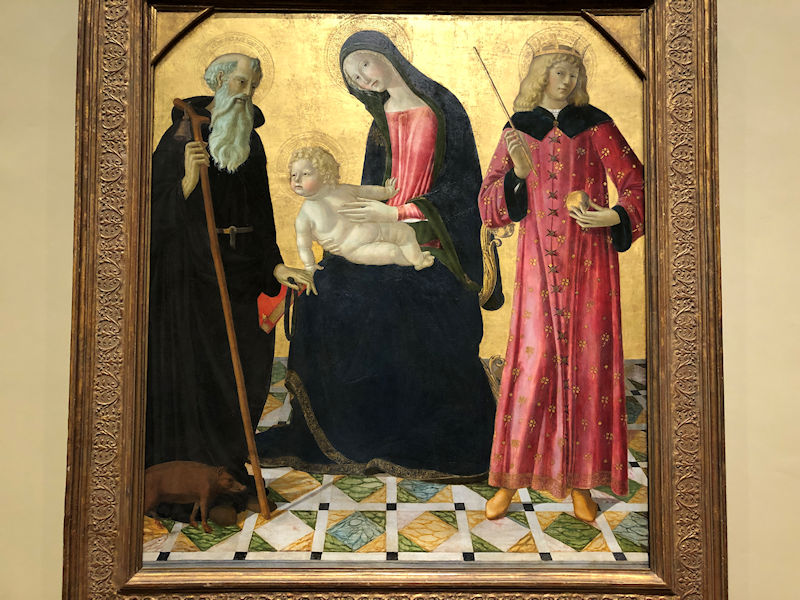
Continuing with the Siena connection, this is by Neroccio de' Landi and features St Anthony Abbot and St Sigismund, King of the Burgundians in the early 6th century, who founded the monastery of St Maurice at Agaune (not far from where we lived for many years) in 515, and was killed by Merovingian warlords in 524 (Theodoric the Great avenged him). Anthony ('the Great', d. 356) is intense as usual, Sigismund is wary, Madonna is demure of course, and the Baby Jesus just wants out. Dated to 1490/95.

Benvenuto di Giovanni again, The Adoration of the Magi, ca.1470/75, with the usual cows and donkeys but with some camels and a horse thrown in. The Magi have halos on as well-- why? Huh?

Neroccio de' Landi of Siena again, this attractive lady is Claudia Quinta, who was a legendary Roman matron who personally towed the barge carrying the 'Great Mother' goddess Cybele up the Tiber to Rome to win her help in ending the Second Punic War successfully, in 204 BC. She was understood to represent a paragon of morality and religious purity (not particularly Christian though). Dated to 1490/95.
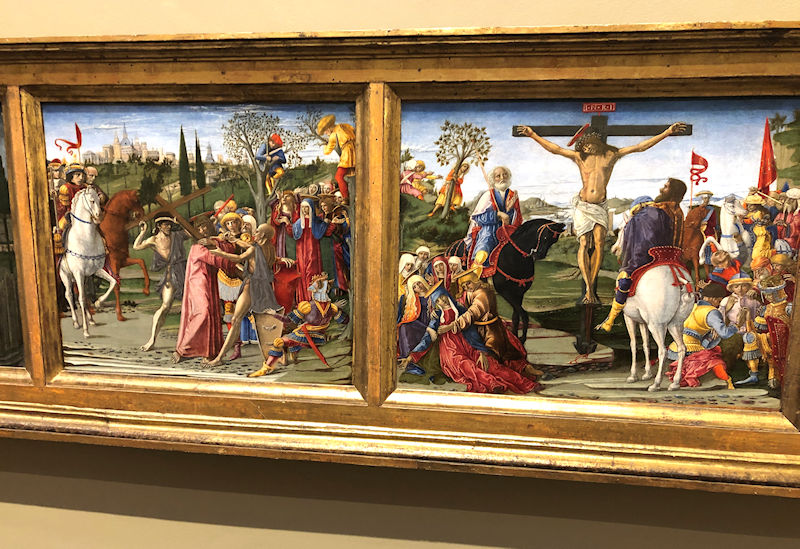
These are some of intriguing panels by Benvenuto di Giovanni illustrating the life of Christ, here Carrying the Cross and the Crucifixion; the cleverest details can't really be seen very well at this range.

The first of these shows Jesus, during his three day gap between crucifixion and resurrection, leading out of Limbo the good people who'd had the misfortune to have lived before He came to preach the way to salvation (squashing the demon under the door). The second shows Christ in his Triumphant Resurrection (squashing some soldiers who'd got in the way). All are dated to 1491.

Here follows a selection of glazed terracotta figures from the 15th & 16th century Della Robbia family of Florence, sculptors who worked mostly in this medium: dad Luca, nephew Andrea, and great-nephews Giovanni and Girolamo, producing individual pieces for patrons along with a workshop producing inexpensive works from molds. This Nativity is by Luca, dated to ca.1460.

This Adoration piece is by nephew Andrea and dated to after 1477.

This glazed and painted figure is by Andrea's son Giovanni and dated to 1510/20. He added more painted figures to the workshop's repertoire.

This painted terracotta of Virgin, Child, and John the Baptist is here attributed to a 'Follower of Andrea del Verrocchio', late 15th century.
 |
 |
The two supercilious young gentlemen, neither looking very congenial, are by Filippino Lippi, ca.1485, and Botticelli, ca.1482/85, respectively.

This on the other hand is a cute little kid, obviously well brought up (painted by Baldassare d'Este, ca.1474/80), who grew up to be Francesco II Gonzaga (1466-1519), 4th Marquess of Mantua.
Not always so cute: he became a leading condottiero or mercenary captain who was commander of Venetian forces from 1489 to 1498, but later joined up with the French and then the Papal forces. He was married in 1490 to Isabella d'Este, the high-cultural and women's fashions arbiter throughout most of Italy, with whom they made Mantua a cultural cynosure, but beginning in 1503 he also had a long torrid affair with Isabella's sister-in-law Lucrezia Borgia, then Duchess of Ferrara. As an adult he was known as an amazingly ugly man (and occasional sodomist), and he died of syphilis in 1519.
Baldassare (1432-1506/1510) is a portraitist thought to have been an illegitimate member of the Este dynasty of Ferrara, possibly even a son of Marquess Niccolò III d'Este. He worked in Milan, Ferrara, and Reggio Emilia.

Our Alison and Ginevra de' Benci, with two portraits of Ginevra on the obverse and reverse by Leonardo da Vinci, ca.1474-78, of this 'much-admired' Florentine aristocratic young woman, possibily done on the occasion of her engagement or marriage at age 16. The National Gallery points out that 'Leonardo's portrait of Ginevra de' Benci is the only painting by the artist in America'. The surrounding foliage is juniper, symbolizing female virtue and also punning on her first name.

This delicate figure is meant to represent Faith, by Mino da Fiesole, near Florence, ca.1475-80.
 |
 |
Both of these marble pieces are wonderful -- the first is made in the 'Style of Agostino di Duccio', post-1460s, and the second is by Antonio Rossellino of Florence, ca.1477.

A Madonna who looks like she's fed up with being the Madonna, with a Baby that might explain why, by Fra Filippo Lippi of Florence, ca. 1440

'The Feast of Herod and the Beheading of Saint John the Baptist', evidently a minor work by the Florentine Benozzo Gozzoli, dated to 1461/62. A simultaneous narrative, it shows Salome dancing at her stepfather Herod Antipas' birthday party and asking, at her mother's instruction, for John the Baptist's head as payment, and then presenting the head to her mother Herodias. All in late medieval clothing (except maybe John the Baptist). (Only one halo in this picture.)

Fra Angelico and Fra Filippo Lippi, The Adoration of the Magi and great masses of other people rushing the podium, including a few without their trousers. And an oversize peacock. Very odd, one would have thought. Date narrowed down to ca.1440-1460.

The Madonna of Humility (ca.1430), by Fra Angelico, with an undernourished Christ Child.

Madonna and a curly blonde Jesus who looks at us as if he's got our number. No baby blessings here. By Domenico Veneziano, dated 1445/50. Though born in Venice, Domenico spent most of his life in Tuscany and Perugia and did a lot of work for the Medici family.
 |
 |
We're entering the earlier 14th century, when few artists knew what people looked like, it seems [witness the anatomical mysteries of the Nursing Madonna theme in the period]. On the left is a Madonna and Child with Five Angels (ca.1335), by Giovanni Baronzio, and on the right, an Enthroned Madonna and Child (ca.1250-1275), straightforwardly attributed to 'Byzantine (possibly from Constantinople)'.

The Coronation of the Virgin (by Master of the Washington Coronation, dated at the bottom as 1324), a bit strange maybe. Is that guy planting a crown on her or adjusting her holy halo, and who is he anyway? God (no patriarch with flowing white beard)? Jesus (just getting round to crowning his mom now)? It's just a bit odd, that's all; but colorful.
 |
 |
On the left, another one from 'Byzantine (possibly from Constantinople', Madonna and Child on a Curved Throne (no kidding), dated ca.1260/80, and on the right, Madonna and Child with Saints and Angels, by the Florentine Bernardo Daddi, dated to the 1330s.

This amazing set would be worth the price of admission by itself, even if there were a price of admission to the National Gallery. The attribution is just 'Veronese, 14th century' and dated to 1321; one can sympathize with the sculptor wanting to remain anonymous.

The Birth of John the Baptist, plus Joseph jotting down his name for the records, and some guy circumcising the baby, yikes. By Giovanni Baronzio, dated to ca. 1335.

Madonna and Child with St Peter and St John Evangelist (ca.1360), by Nardo di Cione.
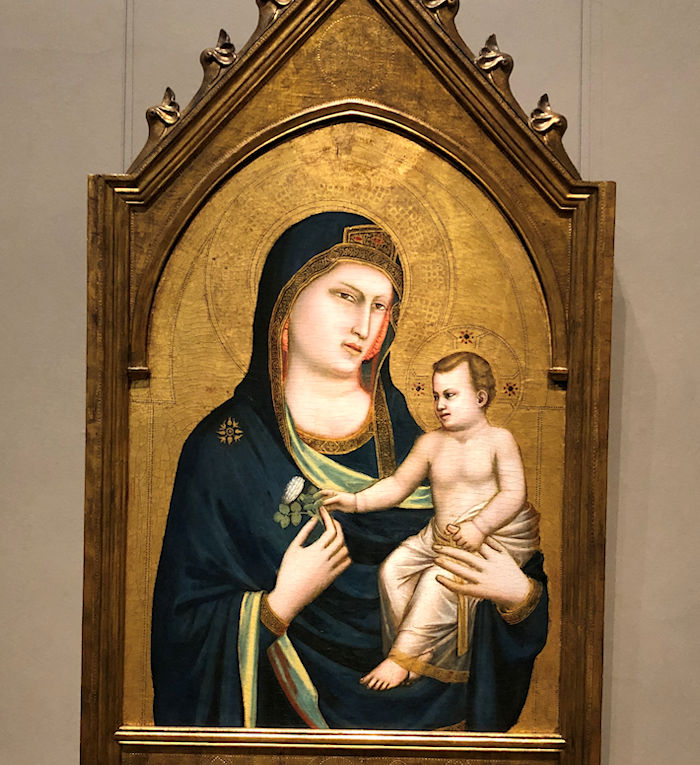
The last of these for today -- A Madonna and Child by Giotto himself, ca. 1310/15

Just to change the subject a bit, this is a bronze bust of the Holy Roman Emperor Charles V Habsburg with his armor but without his arms. It's dated to 1550/68, though Charles retired in 1555 and 1556 and died in 1558. It's attributed to 'Probably Flemish, after a model by Leone Leoni from Milan'. Charles was a hardworking and mostly honest gentleman who ruled (more or less) Spain, the Spanish Netherlands, and much of Italy, and was feudal overlord over most of Austria and the German states, and of course the New World, but from time to time he did make some mistakes, to be honest (e.g., the Sack of Rome).
But the artist is being charitable about the jutting Habsburg lower jaw. Charles could scarcely chew, but later Habsburg generations had it worse.

We're on the move again.

This interesting bronze statue is by Pierre-Eugène-Emile Hébert (aka 'Pete'?), identified as French, living from 1828 to 1893. It was modeled ca.1860/72 and cast by 1882. The disspiriting title of it is 'Amazon Preparing for Battle (Queen Antiope or Hippolyta?) or Armed Venus'. Can we choose?

The 'Thinker' (aka Le Penseur) by Rodin, cast in 1901. Yeh yeh yeh. Everybody's got one of these, if not in bronze, at least in plaster, maybe desk size with a digital clock on it. There are 'about 28 monumental-sized bronze casts' of it -- it was originally entitled 'The Poet', too poor to afford clothing, apparently meant to represent a Dante, too busy thinking to bother with clothing.

Oh, now that's nasty. The Abduction of Hippodamia, grabbed up by a muscular lunatic centaur; ironically her name means 'Tamer of Horses'. It's attributed to Albert-Ernest Carrier-Belleuse (aka 'Al'?), who was French (!), and this is marked as 'possibly with Auguste Rodin'. Cast after 1877.

This is poor old Saint Jerome (working in his study on a very hot day) being hassled by an angel (ca.1625), by a semi-favorite, the estimable Frenchman Simon Vouet, who worked in Italy, especially in Rome, until called back to Paris in his late thirties to become Chief Painter to Louis XIII; one main reason we like him is that he was a friend of an even more favorite Artemisia Gentileschi in Rome and painted her portrait in 1623.

Speaking of whom, this Lute Player (ca.1612-20) was made by Artemisia's father Orazio Gentileschi. (One of Artemisia's best-known self-portraits is of herself as a lute player.)

Speaking of lute players, The Concert (1623) illustrates a bit of the Netherlandish/Italian influence back and forth. Gerard van Honthorst (1592-1656) of Utrecht visited Rome in 1616, imbibed the current styles, went home in 1620, and was part of a group known as the' Utrecht Caravaggisti'. He also visited England briefly in 1628 and painted portraits of King Charles I and Henrietta Maria.

Another special favorite: the Repentant Magdalene (ca.1635-40) by Georges de la Tour, the master of candlelit chiaroscuro scenes. We've long been interested in the church's conflicting interpretations about the Magdalene, the reformed prostitute or the favored right-hand aide of Jesus, and we collect the pictures we've seen. This is meant to favor repentance, of course, with the skull and all, but Donatello shows what her repentance might really look like.

A snuggly version of the Madonna and Child, by Simon Vouet -- he's dated it himself: 'Simon Vouet finxit 1633'. This seems to be considered a minor work of his; certainly there's a much nicer one called the Hesselin Madonna (public domain).

This is François Clouet's 'A Lady in Her Bath' (ca.1571) along with a lot of other people eager to be in the picture.

And a more playful scene (1663), by Elisabetta Sirani, a celebrated painter in mid-17th century Bologna in a family of painters and founder of an academy for women painters; in addition to her teaching, she left over 200 paintings along with etchings and drawings, but died in 1665 in controversial circumstances at the age of 27. As a mark of honor, she was buried in the same tomb as her father's teacher, Guido Reni.

This is a portrait of the Marchese Brigida Spinola Doria, a 22-year-old from the illustrious Spinola family of Genoa who'd just married into the even more illustrious Doria family of that city, made by Rubens during a visit to Genoa in 1606.

A landscape by Rembrandt, The Mill (ca.1645/48), and . . .

. . . one of his many self-portraits (1659), at age about 53.

A delightful picture of a little girl giving money to a poor lad and wondering what we're looking at: Jacob Ochtervelt, A Nurse and a Child in an Elegant Foyer (1663).
 |
 |
Two well-known classics -- left: Death and the Miser (ca.1485/90), Hieronymous Bosch, and right: Jan van Eyck, The Annunciation (ca.1434/36)

Clearly we've wandered into one of the Netherlands rooms, happily: this is Rogier van der Weyden's Portrait of a Lady (ca.1460).
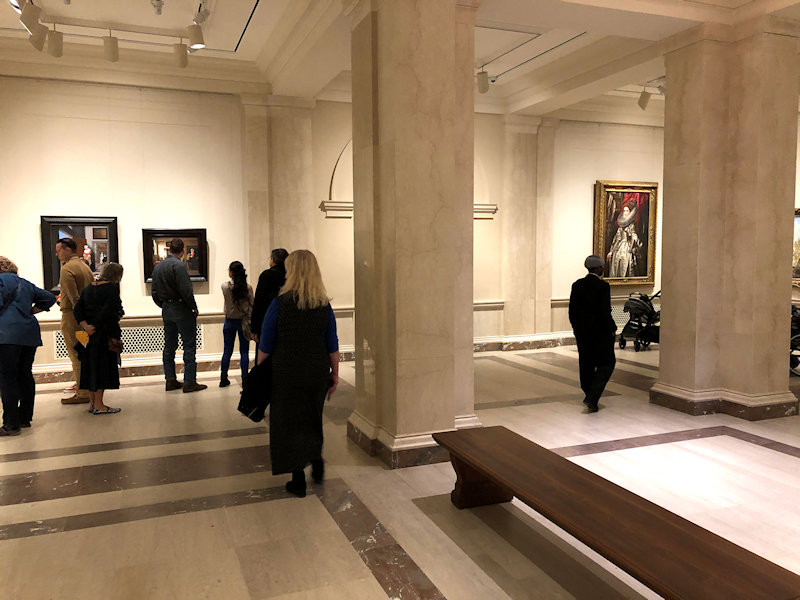
A very relaxed atmosphere here, and time and space to contemplate whatever you like

Canaletto, St Mark's in Venice (1742/44)

Adoration of the Shepherds, by Giorgione (d.1510), a 'founder' of the Venetian School; this attribution, like many of his works, isn't universally accepted, but generally so, though Titian has also been suggested. He came from Castelfranco Veneto, where a few years ago we visited his house/museum and statue.
Castelfranco is also the home base of the Dotto Trains company that makes probably 75% or more of the urban tourist road-trains in Europe.

High marks for this one: marble, ca.1500/10, by a certain 'North Italian (possibly Veronese)'

The marble piece of the Virgin with the Megacrown, and Child, is just identified here as 'French'.
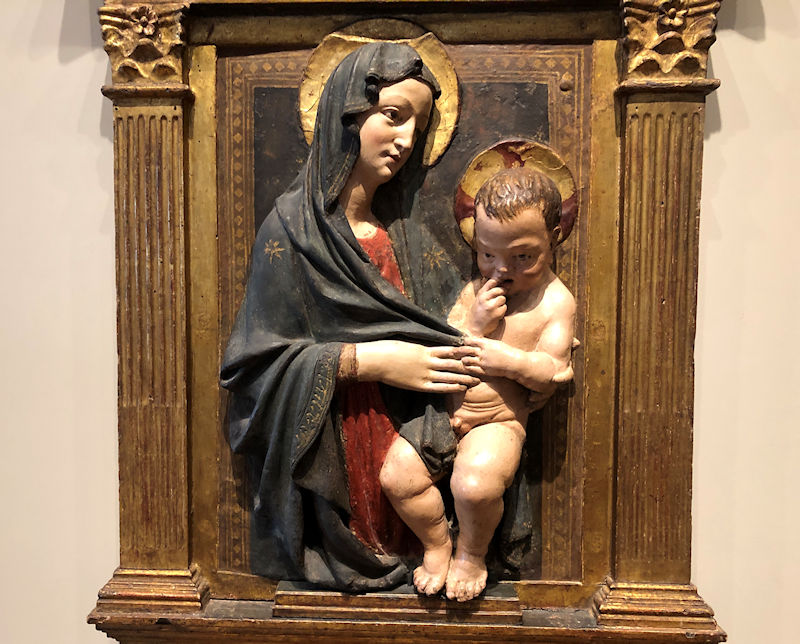
A Madonna with a broken halo and Christ Child possibly picking his nose is by 'Circle of Giovanni di Turino' of Siena, painted terracotta, first half of the 15th century.

Ouch! That's Milo, the legendary Greek wrestler of Croton in Italy, getting bitten on the butt by a lion. Bronze taken from a 1682 marble original by a sadistic Pierre Puget; Milo's got his hand stuck in a tree trunk, otherwise he'd wrestle that lion to pieces.
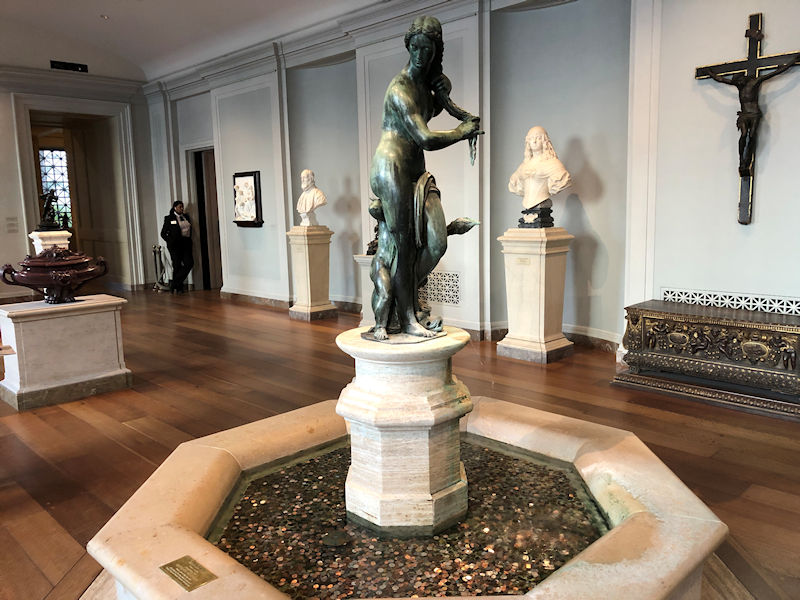
Venus and Cupid (ca.1575/80), bronze, by a 'Follower of Giovanni Bologna', a Fleming working in Italy. It's not true that if you throw a penny into the basin, the statue dances.

It's lunchtime now -- not that the image of The Slaughtered Hog, by the Dutchman Jan Victors (1653), has influenced us in any way. But we're left wondering what that little lad is blowing up, not wanting to know the answer.

After a long lifetime of never having set foot in the National Gallery of Art, one is very glad to have finally got here in time.

And on that note . . . The Lunch.
Next up: The National Museum of the American Indian in Washington, D.C.

 Feedback
and suggestions are welcome if positive, resented if negative, Feedback
and suggestions are welcome if positive, resented if negative,  .
All rights reserved, all wrongs avenged. Posted 19 March 2023. .
All rights reserved, all wrongs avenged. Posted 19 March 2023.
|
 Dwight Peck's personal website
Dwight Peck's personal website






























































